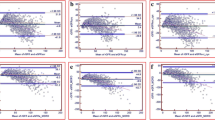Abstract
Background
Indications of dialysis treatment for patients with end-stage renal disease depend on various clinical and laboratory parameters. In this study, we aimed to determine whether standardized serum cystatin C (SCC) equation may be an applicability of marker for dialysis initiation and its relationship to other clearance values among patients with advanced chronic kidney disease.
Materials and methods
A total of 84 patients (45 males, 39 females) aged 19–89 were evaluated in this study. Hemodialysis was indicated according to clinical and laboratory findings, and estimated glomerular filtration rate (eGFR) was according to four different formulas [MDRD, EpiCKD, Cockcroft Gault formula (CGF) and SCC equation].
Results
eGFR values of patients in the study were 7.23 ± 3.26, 7.86 ± 3.78, 15.09 ± 10.88 and 11.31 ± 4.54 according to MDRD, EpiCKD, SCC equation and CGF, respectively. There was a positive correlation between MDRD, EpiCKD and CGF, and between EpiCKD and CGF (p < 0.01). Also, statistically significant correlation was found between SCC equation and CGF (p < 0.05).
Conclusion
SCC equation was not seemed to be an appropriate marker for starting dialysis in patients with advanced CKD.


Similar content being viewed by others
References
Levey AS, Coresh J, Balk E, et al (2003) National Kidney Foundation. National Kidney Foundation practice guidelines for chronic kidney disease: evaluation, classification, and stratification. Ann Intern Med 139(2):137–147
Levey AS, Eckardt KU, Tsukamoto Y et al (2005) Definition and classification of chronic kidney disease: a position statement from Kidney Disease: improving Global Outcomes (KDIGO). Kidney Int 67(6):2089–2100
Coll E, Botey A, Alvarez L et al (2000) Serum cystatin C as a new marker for noninvasive estimation of glomerular filtration rate and as a marker for early renal impairment. Am J Kidney Dis 36:29–34
Madero M, Sarnak MJ (2011) Creatinine based formulae for estimating glomerular filtration rate: is it time to change to chronic kidney disease epidemiology collaboration equation? Curr Opin Nephrol Hypertens 20(6):622–630
Bicik Z, Bahcebasi T, Kulaksizoglu S, Yavuz O (2005) The efficacy of cystatin C assay in the prediction of glomerular filtration rate. Is it a more reliable marker for renal failure? Clin Chem Lab Med 43(8):855–861
Laterza OF, Price CP, Scott MG (2002) Cystatin C. an improved estimator of glomerular filtration rate? Clin Chem 48(5):699–707
Gökkuşu CA, Ozden TA, Gül H, Yildiz A (2004) Relationship between plasma Cystatin C and creatinine in chronic renal diseases and Tx-transplant patients. Clin Biochem 37(2):94–97
Kim SJ, Sohn YB, Park SW, Jin DK, Paik KH (2011) Serum cystatin C for estimation of residual renal function in children on peritoneal dialysis. Pediatr Nephrol 26(3):433–440
Adachi Y, Nishio A (2010) A simple method to evaluate residual renal function by spot urinary cystatin C-to-creatinine ratio in peritoneal dialysis patients. Perit Dial Int 30(4):464–467
Inker LA, Schmid CH, Tighiouart H et al (2012) Estimating glomerular filtration rate from serum creatinine and cystatin C. N Engl J Med 367(1):20–29
Pei X, Liu Q, He J et al (2012) Are cystatin C-based equations superior to creatinine-based equations for estimating GFR in Chinese elderly population? Int Urol Nephrol 44(6):1877–1884
Levey AS, Coresh J, Greene T et al (2006) Using standardized serum creatinine values in the modification of diet in renal disease study equation for estimating glomerular filtration rate. Ann Intern Med 145:247–254
Levey AS, Stevens LA, Schmid CH et al (2009) CKD–EPI (Chronic Kidney Disease Epidemiology Collaboration). A new equation to estimate glomerular filtration rate. Ann Intern Med 150(9):604–612
Hoek F, Kemperman F, Krediet R (2003) A comparison between cystatin C, plasma creatinine and the Cockcroft and Gault formula for the estimation of glomerular filtration rate. Nephrol Dial Transplant 18:2024–2031
Cockcroft DW, Gault MH (1976) Prediction of creatinine clearance from serum creatinine. Nephron. 16:31–41
Stevens LA, Coresh J, Schmid CH et al (2008) Estimating GFR using serum cystatin C alone and in combination with serum creatinine: a pooled analysis of 3,418 individuals with CKD. Am J Kidney Dis 51(3):395–406
Martin MV, Barroso S, Herráez O, de Sande F, Caravaca F (2006) Cystatin C as estimator of glomerular filtration rate in patients with advanced chronic renal disease. Nefrologia 26(4):433–438
Graves JW (2008) Diagnosis and management of chronic kidney disease. Mayo Clin Proc 83(9):1064–1069
Yashiro M, Kamata T, Segawa H, Kadoya Y, Murakami T, Muso E (2009) Comparisons of cystatin C with creatinine for evaluation of renal function in chronic kidney disease. Clin Exp Nephrol 13(6):598–604
Astor BC, Shafi T, Hoogeveen RC et al (2012) Novel markers of kidney function as predictors of ESRD, cardiovascular disease, and mortality in the general population. Am J Kidney Dis 59(5):653–662
Bevc S, Hojs R, Ekart R, Gorenjak M, Puklavec L (2012) Simple Cystatin C formula compared to serum creatinine-based formulas for estimation of glomerular filtration rate in patients with mildly to moderately impaired kidney function. Kidney Blood Press Res 35(6):649–654
Tidman M, Sjöström P, Jones I (2008) A comparison of GFR estimating formulae based upon s-cystatin C and s-creatinine and a combination of the two. Nephrol Dial Transplant 23(1):154–160
Hojs R, Bevc S, Ekart R, Gorenjak M, Puklavec L (2011) Kidney function estimating equations in patients with chronic kidney disease. Int J Clin Pract 65(4):458–464
Conflict of interest
The authors declare no conflict of interest.
Author information
Authors and Affiliations
Corresponding author
Rights and permissions
About this article
Cite this article
Sit, D., Basturk, T., Yildirim, S. et al. Evaluation of the serum cystatin C values in prediction of indications for hemodialysis in patients with chronic renal failure. Int Urol Nephrol 46, 57–62 (2014). https://doi.org/10.1007/s11255-013-0481-4
Received:
Accepted:
Published:
Issue Date:
DOI: https://doi.org/10.1007/s11255-013-0481-4




